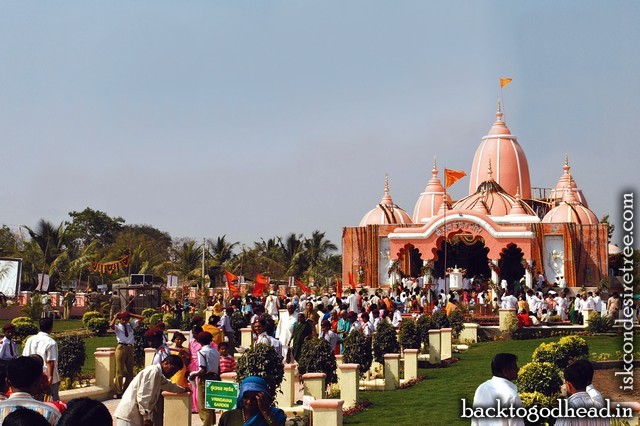In February, a temple opened in Aravade, Maharashtra, the hometown of Lokanath Swami, an ISKCON leader. Maharashtra’s capital is Mumbai, and the state’s chief minister wished to be at the opening, but his boss, Sonia Gandhi, called Congress Party leaders together for a meeting in New Delhi that weekend. State legislators and ministers, though, dropped in with entourages during the ceremonies to express appreciation before large crowds. The four thousand citizens of Aravade (aa-ra-vah-day) invited many relatives from other towns, and almost seven thousand Hare Krishna devotees came from cities in India and abroad. The town’s population nearly tripled for the event.
The temple was built on Aravade’s northeastern perimeter, near the low hills, wide wells, and fields where Lokanath Swami was born and herded animals as a boy. I began noticing the domesticated animals while traveling on a road out to Aravade from the Sangli train station. Bullock teams walked to the Sangli sugar factory with cartloads of harvested sugar cane.
Mighty bullocks often pranced by the house I stayed in, too, their heads and horns bobbing as they pulled one or two passengers around a curve in a bullock cart. It is also common to see people walking a few goats on tethers to keep them from straying. To a Westerner it looks unusual, but around Aravade it is as common as Westerners’ walking dogs on leashes.
I arrived two weeks early, partly to see the preparations and partly because I had just edited Lokanath Swami’s book A Comprehensive Guide to Sanskrit Pronunciation and he wanted to discuss it. Hot, dry days alternated with refreshing cool nights and an ocean of stars, and he showed me how to find the North Star in relation to the Big Dipper.
Traveling worldwide as a Vaishnava renunciant, Lokanath Swami advocates plain living and high thinking. “God made the country and man made the mess” is the theme of another book he is working on. A rough cut of a documentary he is featured in (The Lost Village) premiered at the temple opening. Set in rural Aravade, it is about losing the connections between family, community, cows, and nature by joining the urban rat race.
In the early seventies, Lokanath Swami attended college in Bombay but left to join the International Society for Krishna Consciousness (ISKCON). His family members objected and came up with a proposal: He could live as a devotee, but in Aravade. They promised to build him a small temple, but he rejected the idea. He wanted to live with the foreign devotees in Bombay. Aravade never got that small temple, but it didn’t lose out.
The Greatest Benefits
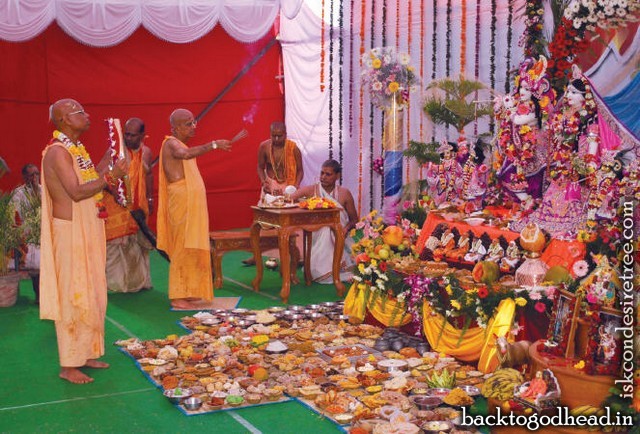
Now his family, village, and region have a two-acre temple complex, and his sister and three brothers chant Hare Krishna. The project’s main objective is to demonstrate principles of plain living and show how village life is favorable for spiritual advancement. A natural Krishna conscious life will protect villagers from degradation, especially the youth. Students from several hundred schools and colleges and people from more than a hundred villages will be visiting. Near the temple they can even see the restored two-room house where Lokanath Swami was born and a few old things are now preserved. Everything else is new: the cows’ stable; a pink-and-white multitowered temple that holds five hundred; a large park with a fountain, lawn, and flowers; and a twelve-room hall exhibiting sacred places and personalities. Aravade has gained a lot.
Each visitor will be brought into communion with Krishna, the Supreme Personality of Godhead. Most people do not know how to use all their energies in His service and think that ordinary activities will make them happy. To show people how to engage in Krishna’s service, Srila Prabhupada opened ISKCON temples and asked his disciples to do the same. To inspire them, he quoted a song by Srila Narottama Dasa Thakura, a great devotee who advised that desire be utilized in serving Krishna: kama Krishna-karmarpane. “I will transform my desire to enjoy something,” sang Narottama, “by serving Krishna instead.”
Srila Prabhupada said during a class in Vrndavana in 1976, “We have constructed this temple with the enthusiasm that there must be a very nice temple for Krishna- Balarama. Somebody else is willing that ‘I must have a very big sky- scraper.’ People may ask, ‘What is the difference between these two desiresn’”
He explained that some people want to own a big house for their sense gratification, while others desire to possess or support an expensive temple because they are devoted to the Personality of Godhead. To elevate and refine human life and realize the universal and inexhaustible source of values such as goodness, truth, and beauty, we must endeavor morally, intellectually, and aesthetically. We cannot be without desire or suppress our desires by force. Some gurus propose ridding ourselves of desire because our desires entangle us in the bondage of never-ending karma. But full freedom from desire is impossible, because desire is part of our nature as persons. Rather than try to suppress desire, we must redirect it, just as we must redirect our senses rather than try to stop them.
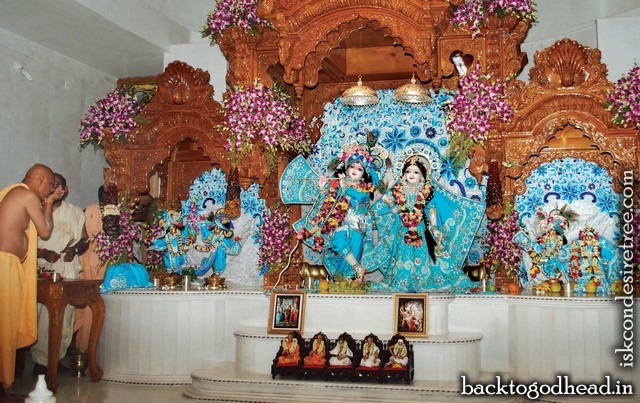
“Yes, I have got my eyes,” Srila Prabhupada continued, “and I want to see Krishna. That is wanted. Even in meditation. Real meditation means seeing within, concentrating the mind on seeing the form of the Lord in our heart. So desire has to be purified. The same desire should be utilized for Krishna’s service.”
Temples help people purify their desires. Indians go to temples at convenient times during the day to see Krishna, and especially in ISKCON temples Krishna is well dressed and worshiped at a high standard. With this beautiful image of Krishna in mind, people go about their daily activities conscious of their identity as His eternal servants. The spirit soul is different from the body and the mind, and spiritual happiness and contentment arise from being united with Krishna’s heart. This makes one’s material desires fade away. When one is spiritually advanced, selfish desires no longer exist.
“One who has tasted the beauty of the Supreme Lord Krishna,” writes Srila Prabhupada, “no longer has a taste for dead, material things.”
The Bhagavad-gita teaches humanity to cease sense gratification by experiencing a higher taste, by chanting Krishna’s holy names, and by eating delicious food that was offered to Him.
Everyone is subjected to the attraction of sense objects, but if we devote ourselves to the service of the Lord, the face of our desires, pride, and so on, will change. Egocentric longing will become a purified, theocentric desire for Krishna’s satisfaction. Then it becomes possible to get out of this puzzle of material existence. Thus devotees offer Krishna at least water and a flower, if not eatables, temple worship, and ultimately their very lives.
Before the Opening
For fifteen years ISKCON has had an ashram in Aravade. Across a relatively peaceful country road from it is the new temple. Before the opening, dozens of volunteers stayed busy planning and organizing. The hired workers readied everything from hand-carved wooden altars to an inlaid-marble peacock that is the fifteen-footwide centerpiece of the temple floor; from huge tent accommodations in fields to a government-financed thousand-foot-long widened road, now named Bhaktivedanta Swami Marg.
Despite the successful outcome, finding skilled labor had been problematic, since workers leave villages to earn city salaries. The new temple, by making Aravade a better place to live, should help it retain some youthful talent. Bright members of the next generation may want a village life with a strong spiritual center.
Beside a playground is a grassy and rocky replica of Govardhana Hill, which Krishna lifted like an umbrella to save Vrindavana’s villagers from a week’s worth of torrential rain. The Supreme Lord knows how to float planets in space, so His lifting Govardhana was child’s play, and it has made Krishna famous for thousands of years.
When I visited the hill twelve feet high and fifty feet long workers were building a footpath around it, composed of 108 pairs of rough reddish rectangular stones, each about the size of an unabridged English dictionary.
The state electricity board, urged by the local government, supplied ISKCON a transformer and a direct line to the regional powerhouse, separate from Aravade’s line. A brief ceremony, a puja, took place to dedicate this electricity to the devotional service of Krishna. During the next few nights, just before the opening, carpenters and marble polishers ran their machines past midnight, bringing nearly to completion the construction work that had started three years earlier.
Finally, after workers spent a day cleaning the site, ISKCON’s guards donned crisp uniforms and the visiting donors and devotees arrived. The grounds quickly filled with individual and congregational chanting of the Hare Krishna mantra, a request to Krishna and Srimati Radharani for engagement in Their loving devotional service.
The Opening Ceremonies
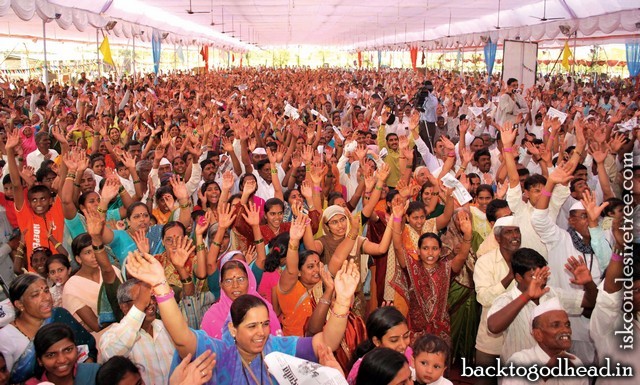
The temple project is named Sri Sri Radha-Gopala Grama (grama means “village”), and Sri Sri Radha-Gopala captured the devotees’ hearts at the opening. (Gopala refers to Krishna as the protector of cows.)
“Lokanath Swami has shared his devotion for Sri Sri Radha-Gopala by inviting all of us,” Radhanatha Swami, an ISKCON leader, said to an enthusiastic crowd before leading the congregational chanting of the Hare Krishna mantra. “Their holy names are the sweetest of the sweet, sweeter than the sugar cane growing in the fields.”
For years, the Aravade devotees have served small deities named Radha-Gopala. At the opening, larger deities with the same names were installed in the new temple. The young men attending Them on the bigger and better altar noticeably took special pride in Radha- Gopala and the new mandira. Also installed, at a second ceremony, were small deities of Caitanya Mahaprabhu and Nityananda Prabhu and medium-size deities of Sri Sri Rukmini-Vitthala and Sita- Rama-Laksmana-Hanuman.
Almost overnight, the temple was transformed from a messy construction site into a treasure house of artistry, lit by a French chandelier. Geometric patterns of inlaid marble lend various colors to the white marble floor. The sculptor Milan Bag, who decades ago made clay bas-reliefs for ISKCON in Mayapur, West Bengal, created in Aravade two long murals for the temple’s entry porch and brightly painted bas-reliefs for the veranda walls and the walls beside the altar. His team also made a pair of colorfully decorated cows that sit flanking the marble steps, and two statues of Vrnda Devi that stand at the opposite entrances to the veranda and can hold a Tulasi plant on their heads.
Visitors can admire the temple from a distance, both because it is set on a rise and because its towers catch everyone’s vision. The architects were Vinay Khandekar and his wife, Anita, from Pune. Drawing closer, the visitors at the opening noticed gorgeous thick streamers of flowers and leaves wrapped around columns, framing doors, and hanging within a dome, from its skylight down to points on its octagonal base. A Mumbai company arranged this abundance of flower power. As florists like to say, “Nothing says ‘I love you’ like flowers.” These flowers were an offering of love to Lord Krishna.
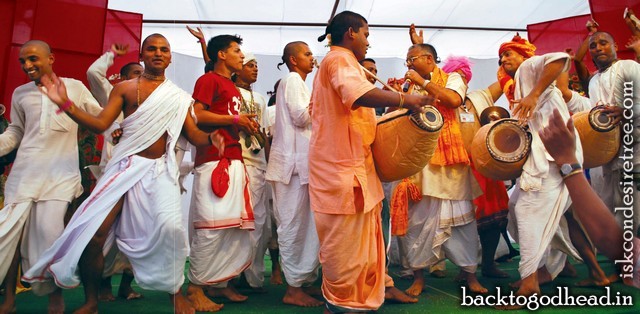
To inaugurate the three-day festival, devotees raised a flag depicting the eagle Garuna, Lord Krishna’s carrier, and also installed his image. Then the initial phase of the installation took place onstage. On the first evening, devotees unveiled the new marble street signs identifying Bhaktivedanta Swami Marg and went on a chanting procession led by an elephant.
All stage events, including two dances and two long musical dramas, were viewable from anywhere in the huge tent and even outside it, thanks to a live video setup. A swing festival entertained devotees who got to pull the rope to swing Radha-Gopala. Near the end, gift giving and a vote of thanks honored the thirty ISKCON VIPs who attended.
The deity installations filled much of the schedule and culminated in a few devotees climbing to the top of the temple’s highest tower to install symbols of Lord Vishnu. They emerged on the ledge at the peak, about 135 feet up. I watched Lokanath Swami up there sprinkling petals on the brass symbols while I sat in the shade, where local children and their parents spoke with me in English. A little girl, at her mother’s prompting, recited a Gita verse for me.
Unlike the first two days of ceremonies, attended mostly by ISKCON devotees, the third day of the festival was advertised to the public. Local guests and their visiting relatives ate lunch at the new temple and enjoyed stage programs and fireworks at the end.
It’s appropriate that a temple in Aravade is dedicated to a natural, spiritual way of life. During the week after the festival, farmers harvested green grapes and dried them to make raisins, and choice samples of the harvest became offerings of devotion to Sri Sri Radha-Gopala.
Tattvavit Dasa recently edited A Shower of Divine Compassion: The Collected Poems of His Divine Grace A.C. Bhaktivedanta Swami Prabhupada. He has also written for BTG about Bulgaria and East Africa.

